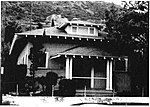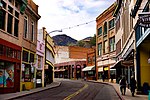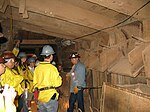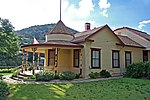St. Patrick's Roman Catholic Church (Bisbee, Arizona)
1915 establishments in Arizona20th-century Roman Catholic church buildings in the United StatesBisbee, ArizonaBuildings and structures in Cochise County, ArizonaCatholic Church in Arizona ... and 7 more
Churches on the National Register of Historic Places in ArizonaGothic Revival church buildings in ArizonaHistoric district contributing properties in ArizonaNational Register of Historic Places in Cochise County, ArizonaRoman Catholic churches completed in 1915Roman Catholic churches in ArizonaUse mdy dates from August 2023

St. Patrick's Roman Catholic Church is a historic church on Oak Avenue, on Higgins Hill in Bisbee, Arizona, United States. It was built in 1915 and added to the National Register of Historic Places in 1995. It was designed by architect Albert C. Martin of Los Angeles.It was deemed significant "because it embodies distinct characteristics of the Late Gothic Revival period of architecture and high artistic value in its decorative fittings, most specifically the stained glass windows and alters."It is a contributing building in the Bisbee Historic District. It is located about 200 feet up Higgins Hill, on the southerly side of Tombstone Canyon.
Excerpt from the Wikipedia article St. Patrick's Roman Catholic Church (Bisbee, Arizona) (License: CC BY-SA 3.0, Authors, Images).St. Patrick's Roman Catholic Church (Bisbee, Arizona)
Tombstone Canyon Road,
Geographical coordinates (GPS) Address Nearby Places Show on map
Geographical coordinates (GPS)
| Latitude | Longitude |
|---|---|
| N 31.444444444444 ° | E -109.92194444444 ° |
Address
Tombstone Canyon Road 305
85603
Arizona, United States
Open on Google Maps










